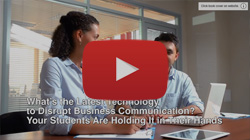. Engaging students and preparing them for success in the modern business world requires a multifaceted approach to teaching business communication. By incorporating a wide range of innovative strategies, instructors can create a dynamic and inclusive learning environment that fosters the development of essential skills. From interactive learning and technology integration to personalized feedback and authentic assessments, these techniques cater to diverse learning styles and provide students with hands-on experience. The following list presents 40 effective classroom strategies that can be implemented to ignite passion, drive success, and equip students with the business communication skills needed to thrive in today's competitive landscape.
Engaging students and preparing them for success in the modern business world requires a multifaceted approach to teaching business communication. By incorporating a wide range of innovative strategies, instructors can create a dynamic and inclusive learning environment that fosters the development of essential skills. From interactive learning and technology integration to personalized feedback and authentic assessments, these techniques cater to diverse learning styles and provide students with hands-on experience. The following list presents 40 effective classroom strategies that can be implemented to ignite passion, drive success, and equip students with the business communication skills needed to thrive in today's competitive landscape.
1. Interactive Learning: Incorporate business-themed gamification elements like virtual company points, professional badges, and leaderboards to boost engagement. Implement activities like role-playing, group discussions, business case studies, and workplace simulations to foster active participation and application of concepts.
2. Technology Integration: Explore virtual reality (VR) or augmented reality (AR) tools for immersive business communication simulations. Utilize online platforms, collaborative tools, and multimedia resources to create a dynamic learning environment that mirrors modern workplace settings.
3. Needs Assessment: Conduct a pre-course survey to gauge individual needs and tailor the course accordingly. Understand students' prior knowledge, career aspirations, and business communication challenges to tailor instructional content.
4. Personalization: Offer individual coaching sessions or mentoring opportunities for students requiring additional support in developing their business communication skills. Encourage self-reflection and provide personalized feedback to support individual development.
5. Writing Across Platforms: Include training on writing for emerging platforms like chatbots and voice assistants.
6. Diverse Content: Use real-world examples, business case studies, and guest speakers from various industries to keep content relevant and engaging for aspiring business professionals.
7. Humor and Storytelling: Weave in business-related humor and relatable stories to enhance information retention and create a more enjoyable learning experience while maintaining a professional tone.
8. Differentiated Instruction: Offer diverse learning activities and assessment methods to cater to different learning styles and preferences, ensuring all students can effectively develop their business communication skills.
9. Microlearning: Divide complex business communication topics into manageable chunks, delivered through short modules or videos, for better absorption and retention.
10. Focus on Active Listening: Conduct activities that emphasize active listening techniques, paraphrasing, and asking clarifying questions in a business context.
11. Presentation Skills: Provide opportunities to practice business presentations with constructive feedback on delivery, content, visual aids, and professional demeanor.
12. Nonverbal Communication: Integrate activities that focus on body language, eye contact, and vocal variety for impactful communication in business settings.
13. Formative and Summative Assessments: Utilize a mix of in-class exercises, peer reviews, self-assessments, and traditional exams to evaluate progress in business communication skills.
14. Timely and Individualized Feedback: Provide constructive and specific feedback promptly to help students improve their business communication skills and build their professional confidence.
15. Self-assessment Tools: Encourage students to reflect on their business communication strengths and weaknesses using self-assessment tools designed for professional development. Pearson’s MyLab for business communication provides self-assessment tools.
16. Emphasize Collaborative Learning: Assign collaborative projects that require students to work together towards a common business goal. Encourage teamwork and communication within group activities to develop interpersonal skills essential for the workplace.
17. Respectful Dialogue: Promote a classroom environment that fosters open communication, diverse perspectives, and a respectful exchange of ideas, mirroring professional business settings.
18. Cultural Sensitivity: Be mindful of cultural differences in communication styles and address them in your content and teaching methods to prepare students for global business interactions.
19. Ongoing Support: Offer resources and opportunities for students to seek additional support and guidance outside of class time to further develop their business communication skills.
20. Continuous Improvement: Conduct regular student evaluations and implement changes based on feedback. Reflect on your teaching practices, gather student feedback, and seek professional development opportunities to stay updated on effective business communication strategies.
21. Stay Current: Incorporate emerging communication tools and trends like AI-powered communication platforms and data-driven communication strategies. Stay current with evolving trends in business communication, such as the rise of remote work, digital communication platforms, and artificial intelligence, and incorporate these trends into your curriculum to prepare students for the modern workplace.
22. Real-time Feedback: Utilize audience response systems for instant feedback during presentations. Provide opportunities for real-time feedback during business presentations or role-plays, helping students identify areas for improvement on the spot.
23. Communication Scenarios: Develop realistic business communication scenarios that simulate various workplace situations, allowing students to practice their skills in a safe environment.
24. Peer Evaluation: Encourage students to provide constructive feedback to their peers, fostering a culture of continuous improvement and mutual support in developing business communication skills.
25. Communication Portfolio: Have students create a portfolio showcasing their best business communication work, including written pieces, presentations, and reflections on their growth as professionals.
26. Flipped Classroom: Implement a flipped classroom approach where students review course material before class, and class time is dedicated to hands-on activities, discussions, and problem-solving exercises related to business communication.
27. Inquiry-Based Learning: Encourage students to explore business communication concepts through inquiry-based learning, where they develop their own questions, research topics, and present their findings to the class.
28. Problem-Based Learning: Present students with real-world business communication challenges and have them work in groups to develop and present solutions, fostering critical thinking and problem-solving skills.
29. Experiential Learning: Incorporate experiential learning opportunities such as internships, job shadowing, or service-learning projects that allow students to apply their business communication skills in real-world settings.
30. Reflective Practice: Encourage students to engage in reflective practice, regularly evaluating their own business communication skills and setting goals for improvement.
31. Scaffolding: Use scaffolding techniques to break down complex business communication tasks into smaller, more manageable steps, providing support and guidance as students progressively develop their skills.
32. Metacognitive Strategies: Teach metacognitive strategies to help students monitor their own learning process, identify areas for improvement, and develop self-regulated learning habits.
33. Interdisciplinary Approach: Collaborate with instructors from other disciplines to create interdisciplinary projects that showcase the importance of effective business communication across various fields.
34. Adaptive Learning: Utilize adaptive learning technologies that adjust course content and pace based on individual student performance, ensuring a personalized learning experience.
35. Peer Teaching: Encourage students to take on the role of teacher by having them present business communication topics to their classmates, reinforcing their understanding of the material and developing their presentation skills.
36. Inclusive Teaching: Adopt inclusive teaching practices that create a welcoming and supportive classroom environment for students from diverse backgrounds, promoting equal participation and valuing different perspectives.
37. Authentic Assessment: Design authentic assessments that mirror real-world business communication challenges, such as creating a company newsletter, drafting a business proposal, or delivering a persuasive presentation.
38. Learning Communities: Foster a sense of community among students by creating study groups, discussion forums, or peer mentoring programs that encourage collaboration and support in developing business communication skills.
39. Differentiated Feedback: Provide differentiated feedback based on individual student needs, offering specific guidance and resources to help each student improve their business communication skills.
40. Growth Mindset: Encourage a growth mindset among students, emphasizing that business communication skills can be developed and improved through dedication and practice, rather than being fixed traits.
 Excellence in Business Communication
Excellence in Business Communication
Excellence in Business Communication is an ideal textbook for instructors looking to implement the strategies mentioned above. The textbook provides comprehensive coverage of essential business communication topics, supporting interactive learning through case studies, role-playing exercises, and group discussions. It integrates technology by offering online resources, multimedia content, and simulations that mirror modern workplace settings.
The diverse content in Excellence in Business Communication includes real-world examples from various industries, catering to different learning styles and preferences. The textbook supports the development of presentation skills, active listening, and nonverbal communication through targeted activities and self-assessment tools.
Regularly updated to incorporate emerging trends like AI-powered communication and remote work, Excellence in Business Communication helps instructors stay current and prepares students for the modern workplace. With its focus on differentiated instruction, inclusive practices, and authentic assessments, this textbook is a versatile resource that supports instructors in creating an engaging, skills-focused learning environment that fosters student success in business communication.
Read more









